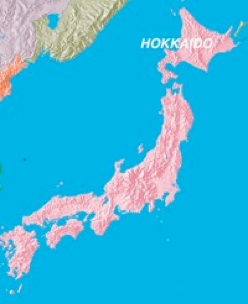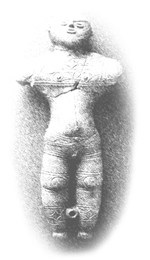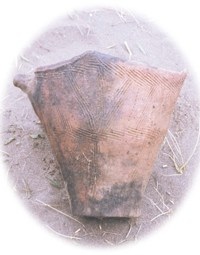Initial-Late Jomon
Useful LinkHakodate Jomon Hakodate Culture Centre
Figurine, Chobonaino Site |
In 1974 I began a long-term research program in Japanese archaeology. My goal was to explore the subsistence-ecological basis of the successful and long-lived Jomon culture of northeastern Japan. My database was plant remains I recovered from a number of sites, mainly Early and Middle Jomon, but I also collected material from Initial and Late Jomon sites as well. The work took place in Minamikayabe and Hakodate, Hokkaido. Plants were a very important part of Jomon life, as they were, and are, for most people. In grad school we discussed the term “hunter-gatherers” and felt it gave too much emphasis to hunting. We all felt that “gatherer-hunters” was a better term but it just doesn’t roll of the tongue quite the same and never caught on. The creation of habitats conducive to useful plants was an important activity around Jomon sites. This process, callled anthropogenesis, is evident in the disturbance, sunlit habitats that were exploited as well as the changes in one species of plant, barnyard grass (Echinochloa crus-galli), that appears to have been domesticated locally (to become what is known as “Japanese” or “barnyard” millet”, or “hie” in Japanese. The issue of whether or not some, most, or all Jomon populations had agriculture is overblown in the literature. People utilized a small number of crops but did not intensify their production to levels that their neighbours in China did. Because of this, archaeologists tend to get caught up in how to classify Jomon. That's not an interesting question for me. There are many populations like the Jomon whose subsistence ecology lies somewhere along a continuum between hunting-gathering and farming. The bigger questions explore how people and other organisms were interacting and what the ecological circumstances were. The Jomon is among the longest-lived Holocene cultures in the world. How this resilience evolved is relevant to us and our survival today. |
Epi-Jomon (ca. 400 B.C. - A.D. 600) |
|
Kohoku Style Pottery
|
The Epi- or Zoku-Jomon is more or less a contemporary of the Tohoku region’s Yayoi period. The Yayoi in Tohoku was an agricultural society whose origins lie in the acculturation of Jomon people to a way of life similar to the one that had been developing in the rest of Japan to the south. Elsewhere in Japan the changes were mainly a result of migration but Jomon populations were higher in the northeast (Tohoku) so migration probably didn’t play as big a role there as it did in the south. Pottery styles have a combination of traits such as Jomon cord-marking and Yayoi-style bases. In Hokkaido the Jomon retained its identity, at least to the extent that intensive food production did not take hold. The pottery exhibits fewer Yayoi influences. The settlement pattern is also distinct from that of the preceding Final Jomon (a misnomer because the Epi-Jomon comes afterward) with pithouses being rare. Sites appear to be short-term, with many burials and burned soil lenses. |
| Plant remains indicate that cultigens were rare, but moving into Hokkaido (rice, barley, hemp). Glass beads were being traded along with Yayoi pottery so interaction between the Yayoi and the Epi-Jomon was regularly taking place. Unlike the preceding Jomon periods, plant remains at the Sapporo Station site are characterized by large concentrations of walnut and chestnut. The deposits are primarily of single species and not mixed. Some levels have few seeds while others have large deposits of knotweeds. One likely model is that people came to the location and exploited plants that were in-season or otherwise productive at the time they were there. Some of the richest examples of art form the Jomon “period” (in the form of cave wall carvings and paintings) are from the Fugoppe Cave site. The Epi-Jomon was a special time and deserves considerable research attention. | |


